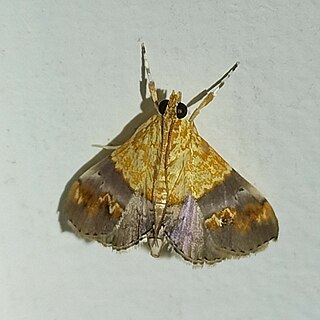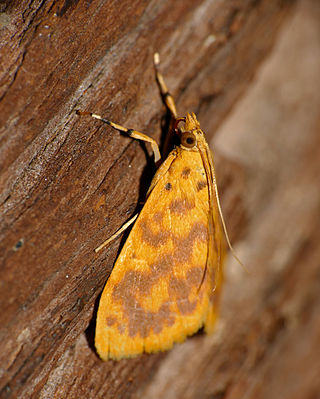
Agrotera is a genus of snout moths in the subfamily Spilomelinae of the family Crambidae. It is the type genus of the tribe Agroterini and currently comprises 28 species distributed in the Afrotropical, Palearctic, Indomalayan and Australasian realm.
Asturodes is a genus of snout moths in the subfamily Spilomelinae of the family Crambidae. The genus is placed in the tribe Margaroniini.

Conogethes is a genus of moths in the subfamily Spilomelinae of the family Crambidae. The currently 17 recognized species are distributed in the Indomalayan and Australasian realm.
Hydropionea is a genus of moths of the family Crambidae. The 13 described species are distributed in Central and South America.
Mabra is a genus of moths of the family Crambidae. It is placed in the tribe Portentomorphini of the subfamily Pyraustinae. The nine species of the genus are mainly distributed in tropical Asia, but M. metallescens and M. russoi are found in tropical Central and South America.

Mnesictena is a genus of snout moths in the subfamily Spilomelinae, where it is placed in the tribe Udeini. The genus was erected by the English entomologist Edward Meyrick in 1884. The currently known seven species are exclusively found on New Zealand and the associated Antipodes Islands and Chatham Islands.

Neoleucinodes is a genus of snout moths of the subfamily Spilomelinae in the family Crambidae. The genus was described by Hahn William Capps in 1948 as a Neotropical split-off of the Old World genus Leucinodes.
Loxocorys is a genus of moths of the family Crambidae. The genus was erected by Edward Meyrick in 1894, and has long been considered a synonym of Luma before it was reinstated as genus with the sole species Loxocorys sericea . A phylogenetic analysis showed that Loxocorys is placed in the Spilomelinae tribe Wurthiini, and in genitalia morphology it shares similarities with Niphopyralis.
Luma is a genus of moths of the family Crambidae. The genus was erected by Francis Walker in 1863.

Terastia is a genus of snout moths in the subfamily Spilomelinae of the family Crambidae. It was described by Achille Guenée in 1854 with Terastia meticulosalis as type species. The genus is currently placed in the tribe Margaroniini, where it is closely related to the genera Agathodes and Liopasia.

Tetracona is a genus of snout moths in the subfamily Spilomelinae of the family Crambidae. The genus was described by Edward Meyrick in 1884 with Aediodes amathealisWalker, 1859 as type species.

Glyphodes bivitralis is a moth of the family Crambidae described by Achille Guenée in 1854. It is native to south-east Asia, including Hong Kong, India, Japan, Taiwan and Thailand. It is also found in Queensland, Hawaii and Maldives.

Herpetogramma licarsisalis, commonly known as the grass webworm or pale sod-webworm, is a species of moth in the family Crambidae.
Dolicharthria charonialis is a moth in the family Crambidae. It was described by Francis Walker in 1859. It is found in China. It was previously placed in the Pyraustinae genus Mabra.

Tetracona amathealis is a species of snout moth in the subfamily Spilomelinae of the family Crambidae. It was described by Francis Walker in 1859 based on material collected at Moreton Bay in Queensland, Australia. It is found in New Guinea and Australia, where it has been recorded in Queensland, northern New South Wales and Western Australia. The species was formerly placed in the genus Agrotera, but in a recent taxonomic revision it was transferred back to the re-instated genus Tetracona, of which it is the type species.
Lathrotelinae is a subfamily of the pyraloid family Crambidae described by John Frederick Gates Clarke in 1971. It currently comprises 45 species in six genera.

Udeini is a tribe in the species-rich subfamily Spilomelinae in the pyraloid moth family Crambidae. The tribe was erected by Richard Mally, James E. Hayden, Christoph Neinhuis, Bjarte H. Jordal and Matthias Nuss in 2019.

Wurthiini is a tribe of the species-rich subfamily Spilomelinae in the pyraloid moth family Crambidae.

Margaroniini is a tribe of the species-rich subfamily Spilomelinae in the pyraloid moth family Crambidae. The tribe was erected by Charles Swinhoe and Everard Charles Cotes in 1889, originally as family Margaronidae.

Portentomorphini is a tribe of the subfamily Pyraustinae in the pyraloid moth family Crambidae. The tribe was initially erected by Hans Georg Amsel in 1956.













